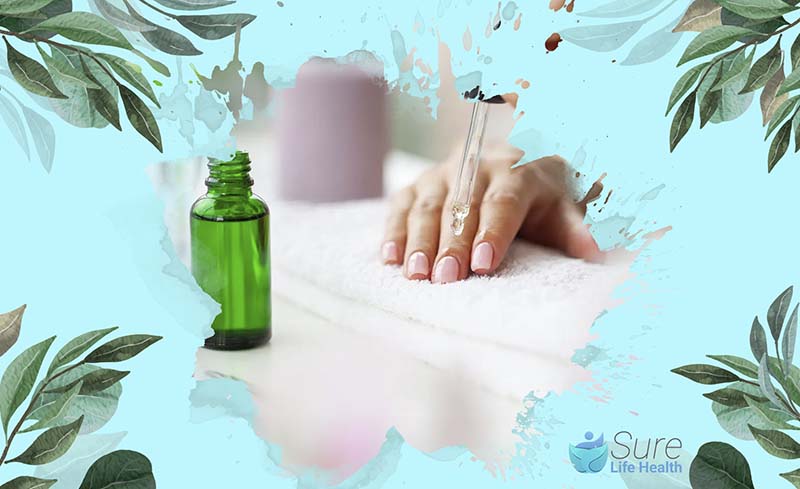Nail fungus is a condition that causes nails to turn yellowish-brown and thicken, leading to cracks. While there are medications available to treat this issue, they often come with side effects. A safer, natural, and effective alternative is using essential oils for nail fungus. This method provides a gentle yet potent solution to manage and improve the condition of your nails.
Important Things to Know Before Using Essential Oils to Treat Nail Fungus
Before you start using essential oils to tackle nail fungus, there are several crucial points to consider:
- Quality and Dilution: Always opt for high-quality, organically certified essential oils of therapeutic grade to ensure effectiveness and avoid harmful additives.
- Skin Sensitivity: Essential oils should be diluted in a carrier oil to prevent skin irritation when applying them directly to affected nails.
- Patch Test: Test a small area of unaffected skin first and wait for 24 hours to check for any adverse reactions before using essential oils on the infected nails.
- Consultation: If you experience any adverse reactions, stop using the essential oils immediately and seek advice from a healthcare professional.
- Pregnancy and Breastfeeding: Pregnant or breastfeeding women should be cautious as some essential oils may have unknown effects. It’s advisable to consult a doctor before using them in such cases.
- Frequency and Application: Apply essential oils at least twice daily on the affected nails using a cotton swab, diluted with water or a carrier oil, and directly on the affected area.
- Choice of Oils: Several essential oils like oregano, tea tree, lavender, lemongrass, eucalyptus, lemon, thyme, and peppermint possess antifungal properties suitable for treating toenail fungus.
- Proper Hygiene: Maintain good foot hygiene by regularly washing and thoroughly drying your feet, moisturizing nails, trimming them straight across, and avoiding walking barefoot in public areas to prevent fungal spread.

Essential Oils for Nail Fungus
Aromatherapy, an ancient practice, utilizes pure essential oils for therapeutic benefits. These oils, derived from various plant parts like stems, roots, and barks, offer healing properties for human ailments. When used for toenail fungus treatment, organic essential oils exhibit antifungal, antibacterial, and antiseptic properties, along with unique active nutrients that aid in natural nail healing and growth.
In this section, we’ll explore some of the best essential oils for toenail fungus recommended by dermatologists. These oils effectively combat yeast infections, restore nail health, and benefit the skin.
Tea Tree Essential Oil
Tea tree oil, with its fresh camphoraceous scent and pale yellow to clear color, blends well with various oils like cinnamon, lavender, and rosemary.
Benefits of Tea Tree Essential Oil
- Treat infections
- Soothe skin conditions
- Combat dandruff and dry scalp
- Address acne
- Reduce inflammation
- Alleviate allergy symptoms
How to Use Tea Tree Essential Oil
- Wash the infected nail with warm soapy water.
- Dilute tea tree oil with a carrier oil if you have sensitive skin.
- Apply 3-4 drops of the mixture on your nails.
- Allow it to soak for 10 minutes.
- Gently scrub the nail using a soft brush.
- Repeat daily until the new nail replaces the old one.
Side Effects Tea Tree Essential Oil
Consuming tea tree oil may lead to confusion, difficulty walking, rash, and coma.

Lemon Essential Oil
Lemon essential oil, with its robust citric aroma and mostly clear color (though it may have a green undertone if derived from green lemons), is commonly used in aromatherapy. Extracted from lemon peel, it offers numerous health benefits and blends well with oils like Eucalyptus and Peppermint.
Benefits of Lemon Essential Oil
- Detoxify and rejuvenate skin
- Soften cuticles
- Penetrate nail fungus cell walls
- Heal infections
- Alleviate respiratory conditions
- Boost the immune system
- Eliminate allergy triggers
How to Use Lemon Essential Oil
- Mix 10 drops of lemon oil with 1 tablespoon of coconut oil.
- Apply this mixture daily on the infected area until discoloration and other symptoms disappear.
Side Effects of Lemon Essential Oil
- May cause rashes and irritation when applied to sensitive skin.
- High doses can lead to dizziness, vomiting, seizures, and other problems.
Thyme Essential Oil
Thyme oil ranges from pale yellow to reddish-brown and exudes a fresh, sweet, and herbaceous aroma. It blends harmoniously with essential oils like Lavender and Rosemary.
Benefits of Thyme Essential Oil
- Increases blood circulation
- Boosts the immune system
- Regulates blood pressure
- Enhances skin care
- Aids in treating toenail fungus
- Contains allergy-fighting properties
How to Use Thyme Essential Oil
- Mix 2 drops of thyme oil with any carrier oil.
- Apply the mixture to the infected area.
- Leave it on for some time.
- Gently scrub the area with a soft brush.
Side Effects of Thyme Essential Oil
- Consumption may cause digestive system upset, headache, or dizziness in some individuals.
- It may also lead to skin irritation for certain people.

Lemongrass Essential Oil
Lemongrass oil boasts a sweet lemony aroma and ranges from dark yellow to amber and reddish in color. It blends seamlessly with essential oils like Lavender and Eucalyptus
Benefits of Lemongrass Essential Oil
- Antibacterial, antifungal, anti-inflammatory, and antioxidant properties
- Helps prevent gastric ulcers or relieve nausea
- Eases diarrhea
- Reduces respiratory inflammation
- Alleviates various allergy symptoms
How to Use Lemongrass Essential Oil
- Mix 2-3 drops of lemongrass oil with jojoba oil.
- Using a dropper, apply the mixture to your toe.
- Repeat the procedure daily for optimal results.
Side Effects of Lemongrass Essential Oil
Lemongrass oil is generally safe to use, but it may occasionally cause skin irritation or a rash.
Peppermint Essential Oil
Peppermint oil is characterized by its sharp, fresh, and menthol aroma, appearing clear to pale yellow in color.
It blends harmoniously with essential oils such as Lavender and Eucalyptus.
Benefits of Peppermint Essential Oil
- Antifungal properties
- Alleviates headaches and migraines
- Combats toenail fungus and relieves pain
- Improves sleep quality
- Reduces inflammation
- Provides relief for allergies
How to Use Of Peppermint Essential Oil
- Apply 2-3 drops of peppermint oil to the infected area.
- Repeat this procedure once daily.
Side Effects of Peppermint Essential Oil
- Burning mouth syndrome
- Diarrhea with anal burning
- Flushing and headache
- Heartburn
Clove Essential Oil
Clove oil emits a pungent and sharp aroma, appearing pale yellow in color. It is a versatile household product utilized for various purposes, from treating inflammation to promoting hair growth. Clove Bud essential oil blends seamlessly with oils like Bergamot and Lavender.
Benefits of Clove Essential Oil
- Treats infections
- Reduces mouth and throat inflammation
- Enhances the immune system
- Reduces stress
- Aids in curing respiratory problems
- Helps control diabetes
- Reduces acne and promotes hair growth
How to Use Clove Essential Oil
- Add 2-3 drops of clove oil to coconut oil.
- Apply the mixture to nail beds and toes.
- Repeat this process twice daily until symptoms diminish.
Side Effects of Clove Essential Oil
- Applying clove oil to the mouth or gums can cause damage to gums, tooth pulp, and skin.
- Injection of clove oil into the vein can lead to breathing and lung problems.

Lavender Essential Oil
High-quality lavender oil emits a sweet, floral, and woody aroma, appearing pale yellow in color.
It blends harmoniously with essential oils like Lemon, Tangerine, Patchouli, Rose, Geranium, frankincense, bergamot, Sweet Orange, Cedar wood, Grapefruit, Rosemary, Clary Sage, etc.
Benefits of Lavender Essential Oil
- Alleviates anxiety
- Eliminates foot odor
- Promotes wound healing
- Exhibits strong antifungal properties
- Fights inflammation
- Treats allergies
- Reduces pain and skin irritation
How to Use Lavender Essential Oil
- Mix 2-3 drops of lavender oil with 1 tablespoon of coconut oil.
- Apply this mixture to your nails twice daily for a week.
Side Effects of Lavender Essential Oil
- May cause headaches
- Could lead to constipation or increased appetite
- Can cause skin irritation when used topically.
Oregano Essential Oil
Oregano essential oil, derived from the leaves and flowers of Origanum Vulgare, is known for its potent natural antibiotic, antifungal, and antiviral properties, attributed to its high carvacrol and thymol content.
This oil effectively combats bacteria and fungi responsible for skin irritation and infections, acting as a protective shield against germs causing fungus. Its versatility and efficacy across all skin types make it one of the top choices for treating toenail fungus.
Benefits of Oregano Essential Oil
- Fights bacteria and fungi, making it ideal for natural cleaning products and skincare formulations.
- Studies suggest it can enhance the immune system, aiding in infection prevention.
- Reduces inflammation, providing relief from pain associated with conditions like arthritis.
- Contains antioxidants that combat free radicals linked to chronic diseases.
How to Use Oregano Essential Oil
Mix with a carrier oil, such as coconut or olive oil, and apply to the skin to treat fungal infections or inflammations. Always perform a patch test first to ensure no adverse reactions occur.
Side Effects of Oregano Essential Oil
- When applied topically without proper dilution, it may cause irritation or allergic reactions.
- Ingesting oregano oil might lead to gastrointestinal upset or interact with certain medications.
Orange Essential Oil
Orange oil exhibits a pale orange-yellow color and emits a sweet, citrus, and uplifting aroma. It blends harmoniously with essential oils like cinnamon, cloves, sandalwood, frankincense, ginger, black pepper, and vetiver.
Benefits of Orange Essential Oil
- Its anti-inflammatory properties aid in treating arthritis.
- Effective in treating toenail fungus and eliminating long-standing nail issues.
- Shows potential anti-cancer properties.
- Acts as a germ and bacteria killer.
- Boosts the immune system.
How to Use Orange Essential Oil
- Using a dropper, apply a few drops of orange essential oil to your toenail.
- Wash it off after 30 minutes.
- Repeat this process two or three times daily.
Side Effects of Orange Essential Oil
- Orange oil typically doesn’t have major side effects.
- It may cause skin irritation, so conduct a skin patch test before regular use.
- If pregnant or breastfeeding, consult your doctor before use.

Myrrh Essential Oil
Myrrh oil is characterized by its pungent and bitter aroma, ranging in color from yellow to amber to dark brown. It blends well with oils like frankincense cinnamon, rosemary,bergamot and sweet orange oils.
Benefits of Myrrh Essential Oil
- Kills harmful bacteria
- Supports skin health
- Heals skin cracks
- Promotes the growth of smooth and stronger nails
- Combats pain and swelling
- Balances hormone levels
- Helps to relax and de-stress
How to Use Myrrh Essential Oil
- Mix myrrh oil with almond oil and apply it to the affected area.
- Leave it on for 15-20 minutes.
- Gently scrub the area using a toothbrush.
Side Effects of Myrrh Essential Oil
- May exacerbate fever symptoms
- Could lead to heart problems
- May lower blood pressure
- Might cause uterine bleeding
Eucalyptus Essential Oil
Eucalyptus essential oil is renowned for its clear, sharp, fresh, woody scent, characterized by a pale yellow hue. It harmonizes excellently with a variety of other essential oils, including cedarwood, chamomile, cypress, juniper, lavender, lemon, marjoram, geranium, ginger, grapefruit, peppermint, pine, rosemary, and thyme.
Scientific research has unveiled its remarkable potential in reducing inflammation, alleviating pain, and regulating blood pressure through inhalation.
Benefits of Eucalyptus Essential Oil
- Eucalyptus oil is known to enhance respiratory conditions, offering relief from coughs and seasonal allergies.
- Its anti-inflammatory properties make it effective in reducing pain and inflammation.
- Eucalyptus oil is recognized for its ability to combat infections.
- Inhalation of eucalyptus oil can enhance mental clarity and focus.
How to Use Eucalyptus Essential Oil
- Apply eucalyptus oil directly to the affected toenail.
- Allow it to sit for 15 minutes.
- Gently wash it off.
- Repeat this process daily for optimal results.
Side Effects of Eucalyptus Essential Oil
While generally safe for most individuals, eucalyptus oil may cause skin irritation in some cases. To mitigate the risk, it’s advisable to perform a patch test on a small area of skin before widespread use.
Conclusion
Nail fungus infections can be painful and cause significant discomfort. Rather than turning to medications or laser treatments, natural remedies like essential oils offer a gentle and effective alternative. For treating this condition, it’s advisable to use the best essential oils for nail fungus that are readily available on the market.
These antifungal essential oils not only aid in curing the fungal infection but also enhance the health and appearance of your skin. Remember, essential oils should always be used in their diluted form to prevent any allergic reactions due to their potent concentration.
Be sure to explore more insightful blogs from Sure Life Health, where we continue to shed light on the latest trends and breakthroughs in health and wellness.
Professor Gaye Cunnane, PhD, MB, FRCPI
As the Director of Health and Wellbeing at RCPI, Professor Gaye Cunnane is at the helm of initiatives aimed at enhancing the health and well-being of RCPI Trainers and Trainees. Her role extends beyond administration; she is also a respected clinical professor of rheumatology and a consultant rheumatologist at Trinity College Dublin (TCD) and St James’s Hospital. Prof. Cunnane’s medical journey began at TCD, where she graduated from medical school, and her path has been marked by both clinical and academic excellence.
After completing her basic clinical training in medicine, she embarked on PhD studies at University College Dublin and St Vincent’s University Hospital. Her research during this period was focused on prognostic markers in early inflammatory arthritis, a project that saw her collaborating with esteemed universities across Europe, including in Switzerland, The Netherlands, the UK, and Sweden.
Prof. Cunnane’s career took her to the University of California, San Francisco, where she spent three years delving into research on new treatments for lupus. Her academic prowess led her to the University of Leeds in 2001 as a senior lecturer, before returning to Ireland in 2003 to assume her current roles. She has also served as the National Specialty Director for Rheumatology training in Ireland, Programme Director for Basic Specialist Training with RCPI, and as a past President of the Irish Society for Rheumatology.
PUBLISHED ARTICLES
“Rheumatic disease differentiation using immunoglobulin G sugar printing by high-density electrophoresis”: Published in The Journal of Rheumatology, this study reflects her in-depth investigation into rheumatic diseases.
“Benefits of exercise in patients with rheumatoid arthritis: a randomized controlled trial”: This research work, highlighting the positive impact of exercise on rheumatoid arthritis, underscores Prof. Cunnane’s dedication to practical, patient-centered research.
Additionally, Prof. Cunnane has made notable contributions to the Annals of the Rheumatic Diseases, discussing early referral, diagnosis, and treatment of rheumatoid arthritis. She has also been involved in a study on the NCBI platform investigating exercise benefits in rheumatoid arthritis patients.
Professor Gaye Cunnane’s career is a testament to her commitment to improving patient outcomes in rheumatology through rigorous research, clinical excellence, and dedicated teaching. Her work continues to influence the field of rheumatology, both in Ireland and internationally.

